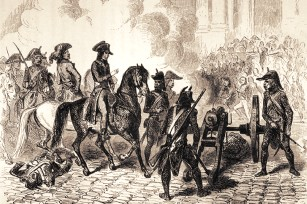The new constitution that the Convention was considering in the summer of 1795 promised to satisfy almost all of the expectations of the constitutional monarchists, the Monarchiens. The new regime would be based on direct democracy, rather than popular representation, and executive power would be held by a Directory of five members. This could then easily be transformed into a constitutional monarchy by replacing these five Directors with a king. Indeed, this change could be effected with the support of a majority vote in both houses created by the new constitution: the Five Hundred and the Ancients. In the current political climate, this was a realistic possibility.
The Situation

Enlarge
A majority of the Convention did not want to see the monarchy restored. The regicides, in particular, were fearful of this possibility. On 4 Fructidor Year III, the Convention ratified a decree stating that two-thirds of any future deputies should be former members of the Convention.
This decree, as well as the new Constitution, was put to an electorate vote. The decree was adopted (167,758 in favour, 95,373 opposed) despite the advice from the Monarchiens to reject it. The text of the new Constitution was also ratified by a vote of 914,853 in favour versus 41,892 opposed.
Convinced that the vote had been rigged, the Monarchiens decided to attempt to overturn the decision by force. While the royalist sections (headed by the Le Peletier group) met on 11 Vendémiaire without much enthusiasm, the Convention responded energetically by declaring itself to be permanent and by establishing an extraordinary commission of five members including Paul Barras. It also began recruiting unemployed officers to defend its members making sure to choose those officers who were known for their republican (even extremist) convictions.
On 12 Vendémiaire, the special commission ordered General Jacques de Menou de Boussay to confront the royalist groups. His weak response earned him immediate dismissal and the commission turned to another unemployed general who had been known to Barras since the Siege of Toulon: Napoleon Bonaparte.
Napoleon Bonaparte's Role
During the night of 12-13 Vendémiaire, the royalists groups became armed and radical. Now, their leaders were royalists in favour of an absolute monarchy. A coup d'état was planned for the next day.
With 25,000 men at their command, the royalists vastly outnumbered Bonaparte who had between 5,000 and 6,000 soldiers at his disposal. However, his preparations were already in place. He was aided by Joachim Murat who he had sent to retrieve the canons from the Sablons camp. Now, all the roads leading to the Convention were in their line of fire.
The royalist groups surrounded the Convention around three o'clock on 13 Vendémiaire. Barras gave the order and Bonaparte opened fire. The shooting lasted 45 minutes. When it was over, 300 royalists were dead, particularly in front of the Church of Saint-Roch in the rue Saint-Honoré and the rest had fled. The Republic and the Convention were saved.
The Consequences
The resulting reprisals were light by the standards of those times. Only ten death sentences were announced in the days that followed.
As for Napoleon Bonaparte, he was promoted to général de division (major general) and Commander-in-Chief of the Army of the Interior.